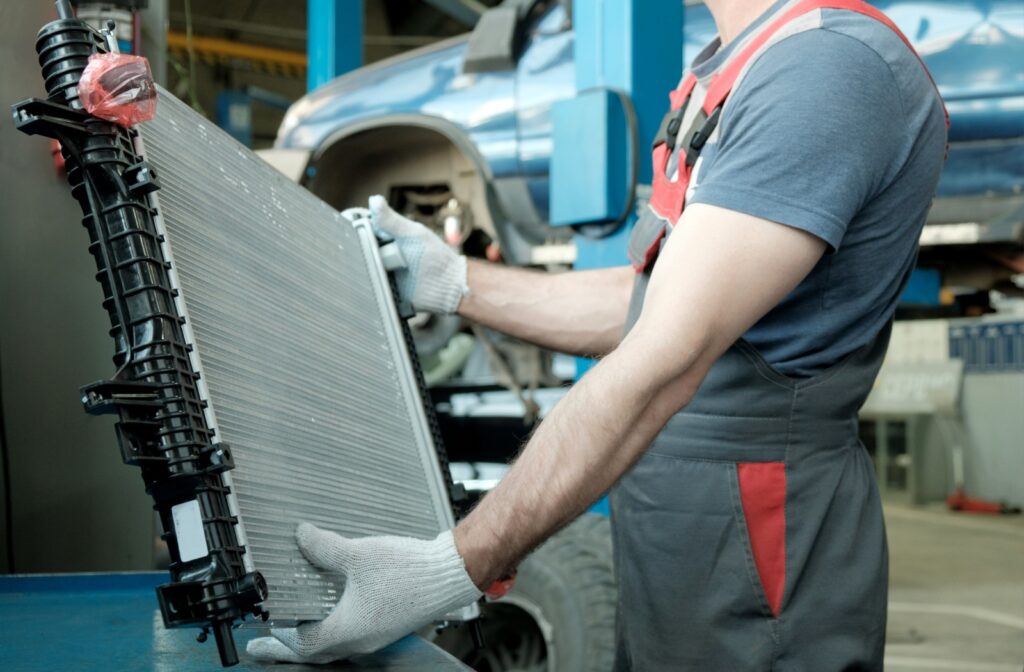The radiator is an often-underappreciated workhouse essential to keeping your vehicle or machinery running smoothly. But sometimes, the critical components can begin to act up. Whether due to damage, contaminant buildup, or even a simple plug, a damaged radiator can pose a significant hazard to an engine. So, how do you identify—and repair—a plugged radiator?
Begin by visually inspecting your radiator for signs of damage or fluid buildup. If there are any cracks or visible damages, immediately seek professional support. If there is no visible damage and the radiator is simply plugged, drain the existing coolant and flush it with water.
Radiators can be tricky. If you are unsure how to repair your radiator, immediately stop any fixes or maintenance and seek the help of a radiator expert.
Why Are Radiators So Important?
The common denominator for almost all operations is the engine, from the largest industrial machinery to heavy-duty trucks. The harder and longer an engine works, the hotter it gets—especially in demanding situations and environments. The engine needs to be properly and efficiently cooled to keep doing its job, and the radiator does this.
The radiator circulates the coolant mixture through the engine and helps disperse the heat into the outside environment. This allows the engine to maintain a steady and optimal temperature without overheating, allowing it to continue doing its job uninterrupted.
What Happens if the Radiator Is Plugged?
However, radiators, like engines, are complex pieces of machinery, and they can be vulnerable to potential problems. Due to their structure, a radiator can become plugged in some circumstances. Rust, debris, and other contaminants can also compromise the radiator’s ability to function properly.
Eventually, this can lead to:
- The engine overheating
- Issues with the vehicle or machine’s climate control
- Poor fuel efficiency
- Additional strain on the engine
This can eventually lead to long-term damage to the engine, making it essential to recognize the signs that something may be wrong with your radiator.
How to Tell if Your Radiator Is Not Working Properly
So, how do you tell if something is wrong with your radiator? Several signs can indicate a problem with your radiator, including:
- A spike in the temperature gauge, potentially indicating a problem with your cooling system
- Leaks or puddles, typically green, orange, or red, depending on the coolant used, under the vehicle or machine when stationary
- Steam coming from under the hood when the engine runs, which indicates that the coolant is leaking or evaporating on a hot engine part
It can help to visually inspect your radiator often. Problems can often be noticed during a quick inspection; pay attention to any cracks, rust, sludge, or discolouration in the coolant liquid. If you notice any problems, it becomes essential to immediately try and repair your radiator to prevent further damage to your engine.

How to Fix a Plugged Radiator
Fixing a plugged radiator can be tricky. Before attempting any repairs, it is essential to understand that some problems simply cannot be fixed alone—especially when considering heavy-duty trucks or industrial machinery. Always refer to any existing manuals or handbooks before attempting a fix.
If you do not know how to properly repair a plugged radiator, seeking professional support can be particularly helpful; this way, you significantly lower the risk of damaging your radiator.
For simple plugs, though, it can help to begin by fully flushing the system. This involves draining any existing coolant still in the system and flushing it with water. A standard radiator flush kit can do this, but it can be intensive. If you are uncomfortable performing this process, leave it to the professionals.
If the radiator does not work properly after replacing the coolant, it may be time to visit an expert.
Tips for Properly Maintaining a Radiator
Like any part of a vehicle or machine, your radiator needs regular maintenance to prevent problems. Make it a habit to inspect your radiator from time to time and look for any signs of problems, including:
- Rust
- Cracks or chips
- Discolouration of coolant, which indicates contamination
- Unusual noise coming from the radiator area, which can signal a failing pump or blockage
- Overheating despite adequate coolant levels points towards a potential blockage or malfunction within the radiator system
Along with the inspection, make sure that you:
- Check your coolant levels and top it off when needed, but only use appropriate coolant
- Change your coolant if there is any sludging or solidification
- Regularly service your radiator as advised
This gives you a better chance of keeping your engine running smoothly.
How City Wide Radiator Can Help
Whether a truck or industrial machinery, your radiator is crucial to keeping an engine properly functioning. If you notice any problems with your radiator or have any questions, reach out to our team at City Wide Radiator. We have decades of experience in this field and can help, so contact us today.
